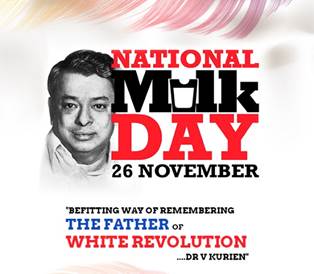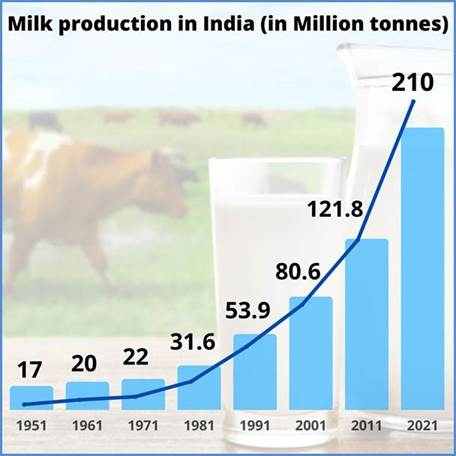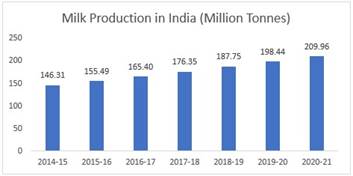
Disclaimer: Copyright infringement not intended.
Context
- The Department of Animal Husbandry and Dairying is celebrating “National Milk Day” to commemorate 101st birth anniversary of the “Father of the White Revolution in India”, Verghese Kurien also known as the Milkman of India.
National Milk Day
- To highlight the importance of milk and its benefits, National Milk Day is observed on November 26 every year. It is the birth anniversary of Dr. Verghese Kurien is called the Father of the White Revolution.
Operation Flood
- Operation Flood, launched on 13 January 1970, was the world's largest dairy development program and a landmark project of India's National Dairy Development Board (NDDB). It transformed India from a milk-deficient nation into the world's largest milk producer, surpassing the United States of America in 1998.
- Within 30 years, it doubled the milk available per person in India and made dairy farming India's largest self-sustainable rural employment generator.
- It was launched to help farmers direct their own development and give them control of the resources they create. All this was achieved not merely by mass production, but by production by the masses; the process has since been termed the "White Revolution".
- Dr Verghese Kurien, the chairman and founder of Amul, was named the Chairman of NDDB by Prime Minister Lal Bahadur Shastri. Kurien thrust the program towards success and has since been recognized as its architect.
Tracing the History
- During the 1950s and 1960s, India had a milk shortage and was dependent on imports; annual production growth was negative for several years. Throughout the first decade after independence, milk production recorded a CAGR of 1.64%, which fell to 1.15% during the 1960s.
- Despite having the world’s biggest cattle population, the nation generated less than 21 MT of milk annually.
- The National Dairy Development Board (NDDB) was established in 1965 to assist the Operation Flood programme, which was to be executed in stages, in establishing the Anand Pattern of dairy cooperatives throughout the country.
- Kurien and his team started working on the project’s launch, which called for establishing Anand Pattern cooperatives in milk sheds throughout the nation, from which liquid milk produced and purchased by milk cooperatives would be carried to cities.
Operation Flood was implemented in the following phases:
- Phase I (1970–1980)The sale of butter oil and skim milk powder provided by the European Union (formerly European Economic Community) through the World Food Programme helped to fund the project.
- Phase II (1981–1985)increased the number of milk sheds from 18 to 136; urban markets expanded the outlets for milk to 290. By the end of 1985, a self-sustaining system of 43,000 village cooperatives with 42,50,000 milk producers had been covered.
- Phase III (1985–1996)enabled dairy cooperatives to expand and strengthen the infrastructure required to procure and market increasing volumes of milk. This phase added 30000 new dairy cooperatives, which led to a total of 73,000.
Milk Production in India
- Today, India is the largest producer of milk in the world, contributing 23% of global milk production.
- During the 1950s and 1960s, the situation was radically different. India was a milk-deficit nation dependent on imports, and the annual production growth was negative for several years.

Dairy Industry in India
- The dairy industry in India is the largest globally, accounting for 23% of global milk production. The industry contributes 5% to the national economy and directly supports more than 8 crore farmers.

- The major production area of dairy products in India is Uttar Pradesh, Maharashtra, Himachal Pradesh, Madhya Pradesh, Punjab, Rajasthan and Tamil Nadu. Competition in the Indian dairy industry has always been robust. Amul, Mother Dairy, Orissa State Cooperative Milk Producers Federation, Dudhsagar Dairy, Aavin, and Kwality Limited are some of the major players in the dairy industry in India.
Note:
Every year, since 2001, June 1 is observed as World Milk Day by the Food and Agriculture Organisation (FAO) of the United Nations to acknowledge the importance of milk as global food and to celebrate the dairy sector. In India, the birthday of Dr. Verghese Kurien, on November 26, is observed as National Milk Day.
Challenges in the Dairy Sector
Despite the exponential growth of the dairy industry, India is still facing challenges of poor milk quality, low yield, lack of infrastructure and a fragmented production. A number of infrastructure related bottlenecks are still present in both back-end and front-end supply chain.
Some of the challenges are mentioned here:
- Breeding infrastructure and genetics: –The success of Indian dairy was mostly due to rising number of animals not productivity. When the resources are limited, it is imperative to increase the productivity per animal. There is a high demand of good animal genetics, breeding infrastructure and advance breeding methods such as artificial insemination, embryo transfer etc.
- Animal feed and fodder: –There is an acute and ever growing shortage of green fodder and good quality feed. Growing trend of high breed animals is creating a huge demand for good quality feed and fodder to cater the dietary requirement of milking animals. Also in order to avoid many health and nutrition related complications prophylactic approach is driving the use of feed pre-mixes
- Animal health:- Good healthcare and animal disease diagnostic solutions are required to address the gap. As above high yielding animals demand extra care and over the years this trend is driving the animal health segment.
- Farm-mechanization:- Despite being the country of 1.25 Billion population there is growing shortage and cost of labour. Farm mechanization is being welcomed by farmers to address the situation.
- Cold chain infrastructure: –There is a lack of required infrastructure of chilling plants and bulk coolers to prevent contamination and spoilage at village level. This segment is bound to see growth opportunities as the government and private sector is investing heavily in it in order to secure sufficient procurements.
- Power availability:- Many chilling plants suffer due to shortage of electricity and do not run optimally leading to poor quality and shelf life of milk. The opportunity within this segment could be solar powered milk chillers.
- Quality testing infrastructure and trained work force:- Adequate quality testing infrastructure is not available at milk collection centres. The problem is compounded by the lack of trained manpower to undertake quality testing. At the consumer end, the demand for safe food is emerging fast and thus creating high opportunity.
- Processing equipment and food ingredients: Growing consumer awareness and shifting lifestyle are forcing processors to move towards the product innovation and thus a growing demand of high quality equipment and various food ingredients.
- Production not optimum: According to the reports of International Farm Comparison Network (IFCN- a global network), India produces around 137.5 million tonnes of milk with over 300 million of cattle population. While USA, produces around 84.3 million tonnes of milk with almost one third cattle population. This shows that India is lacking scientific and technical skills and also the infrastructure required for optimum results. The average milk production per animal is as low as 3 litres per animal/day compared to 30 litres per animal/day in developed nations.
- Policy and regulatory issues-Agriculture is a state responsibility in India, and the State Department of Animal Husbandry, Dairying and Fisheries, within the Ministry of Agriculture, is responsible the dairy activities. Consequently, the focus of the activities and budgetary allocation is biased towards agriculture rather than livestock.
- Malpractices:
- Calves are weaned forcefully within just few days.
- Cattles are seen getting tortured and not given optimum living standards.
- Cows and buffaloes are pumped with hormones in an unscientific manner for increasing production.
- Diseased dairy animals are medicated on their own without proper veterinary assistance or left untreated to save the business running costs.
- Milk processing companies are mostly benefited by the rules and regulations and dairy farmers have least hand in milk pricing and earn very low profits.
- Feed, fodder and water scarcity in some parts of year.
- Lack of education and technical knowledge in unorganized sector farmers.
Government Initiatives to Boost Dairy Industry
The government has taken several initiatives for the development of the dairy industry in India. Few initiatives undertaken by the government to further boost the opportunities in the dairy sector in India are as follows:
Rashtriya Gokul Mission
- To enhance milk output and productivity, which will increase farmers’ income from dairying, the Rashtriya Gokul Mission aims to genetically improve the cattle population and promote and conserve indigenous cattle breeds.
- Under the mission, farmers now have access to several cutting-edge technologies at their doorstep, including sex-sorted semen, IVF technique and genomic selection.
National Programme for Dairy Development (NPDD)
- NPDD has been in place since February 2014 and aims to build or strengthen infrastructure for the production of high-quality milk as well as for the procurement, processing, and marketing of milk and milk products through the State Implementing Agency or State Cooperative Dairy Federation
- The programme’s objectives include enhancing the quality of milk and milk-derived products and growing the organised market share for procurement, processing, value addition and marketing.
Dairy Entrepreneurship Development Scheme (DEDS)
- DEDS is being implemented by the Department of Animal Husbandry, Dairying, and Fisheries to create self-employment opportunities in the dairy industry.
- It covers activities such as improving milk production, procurement, preservation, transportation, processing and marketing by offering back-ended capital subsidies for bankable projects. The National Bank for Agriculture and Rural Development is carrying out the programme.

Exports of Dairy Products
- India’s export of dairy products has witnessed a steady rise over the last three years. In 2021-22, India exported 108,711 MT of dairy products to the world, with key export destinations being Bangladesh, UAE, Bahrain, Malaysia, Saudi Arabia and Qatar.
- India exports value-added dairy goods such milk albumin, milk powder, butter, butterfat, cheese (like cheddar and colby), infant food preparations, and spreads.
Kisan Credit Card(KCC):
- This scheme allows dairy farmers to get a short term credit at reasonable rate of interest for their requirements.
Foot and Mouth Disease Control Programme:
- This scheme was launched for subsequent eradication of F.M.D. implementing biosecurity measures and providing free vaccination drives.
National Programme for Bovine Breeding and Dairy Development(NPBBDD):
- Under this scheme, establishment of milk storage facilities, bulk milk coolers, milk processing units, milk testing laboratories was done for dairy farmers.
Future Prospects
There is a lot to do to address the above-mentioned challenges-
The future of Indian dairy depends highly upon its ability to improve the backward chain integration and on the growth and competitiveness of emerging dairy sectors. An increasing magnitude of milk processing capacity is going to put a lot at stake on the procurement of quality milk. In such a scenario, there will be a lot of processors investing in developing the backward chain as well as creating cold chain infrastructure. The approach is likely to bring more farmers in the reach of the organized sector. These developments will drive the entire chain rapidly and are already resulting in a lot of progress. In fact, India’s expanding cooperative and private sector milk-processing enterprises are gradually becoming active in facilitating changes in the current small-scale structure of dairy production, improved animal feeding practices, and gains in productivity and marketing. A lot of innovation is taking place at consumer-end and thus the requirement of new technology, machinery, packaging solutions, food diagnostics and food ingredients is increasing.
SWOT analysis of performance drivers
|
Strengths
|
How to build on them
|
- Large number of small and marginal farmers involved in dairying
- An effective marketing channel helps to meet the demands of the urban consumer
- Very large number of animals and huge scope to enhance productivity
- Self-sufficiency in medicine production and do not have to rely on exports
|
- Strengthen economic viability of dairy farms by interventions on the input side as well as ensuring more fair farmer prices
- Increase the link between rural production areas and urban markets
- Focus on strengthening the indigenous breed to help significantly enhance productivity
- Ensure availability of quality medicines by strengthening regulatory framework for quality
|
|
Weaknesses
|
How to correct them
|
- Large share of milk (70–85%) of marketable surplus goes through informal channel where quality is a big concern
- Sometimes quality is an issue in the formal channel as well
- Very little competition to cooperatives because private sector was not allowed to participate in until recently
- Farmers do not share in the benefits of high demand because of poor governance of cooperatives
- Milk production is scattered over a large number of farmers producing miniscule quantities
- Milk distribution is limited to urban and peri-urban areas
- Low milk prices because of lower prices declared by cooperatives, which results in low prices of milk paid by all players
- Ad hoc export policies and a ban on exports
- Quality of milk and milk products are a barrier to entry to the export market, especially the EU and the USA
- Lack of policy focus on strengthening indigenous breeds
- Non-existent extension facilities
- Farmers’ prices are not based on fat measurement, which affects their profitability
- Because of low access to credit and risk-taking ability, farmers cannot increase their herd size
|
- Focus on quality issues even in the informal channel by training traders and by enforcing food quality regulations
- Develop infrastructure and training for clean milk production
- Support a fair playing field for the private sector
- Bring about changes in cooperatives to make them true representatives of farmers instead of functioning as parastatals.
- Support to dairying as an enterprise to encourage commercial dairy farming and encourage production and productivity by extension and breed development
- Enhance packaged milk distribution in more areas
- Strengthen dairy farmer cooperatives to enable farmers to get a higher price for milk
- Create rational export policy to enable farmers to take advantage of higher prices
- Strictly implement quality regulations and improve infrastructure and training for quality
- Strengthen the breed development programmes
- Strengthen extension facilities
- Create policy regulations to make mandatory testing as a basis for setting milk price
- Increase access to credit through dairy farmer organizations and other agencies
|
|
Opportunities
|
How to pursue them
|
- Increased farmer income by exploiting the high demand
- Increased consumer sophistication and awareness of quality reception of quality packaged products (though slowly)
- Entry of large corporations in retailing, which can lead to more investment
- Immense scope to enhance governance of dairy farmer organizations and thus enable dairy farmers to demand higher prices
- Potential for exports due to low cost of production
- Overall positive growth environment, which is triggering the Government to enhance infrastructure
|
- Create policies and activities geared towards enhancing dairy farming activity by increasing, production, productivity and ensuring fair farmer price of milk
- Establish enabling policy environment to enhance investment
- Create policy support to enhance governance of producer companies
- Focus on quality issues that are a barrier to exports
- Encourage private sector to increase investment in dairying
|
|
Threats
|
How to avert them
|
- Large portion of the population does not care about quality issues in milk
- Because of high price sensitivity for dairy products, people are not willing to pay for quality
- Significant increase in maize prices can increase feed prices
- Large informal markets that extend credit are constraining farmers
- Low productivity and scattered production leading to high cost of transportation
- Emphasis on milk fat and not on SNF content maintaining relatively lower prices of milk
|
- Initiate consumer education about the negative health impacts of unpackaged products
- Develop packaging in small quantities to meet the needs of the poor
- Increase milk prices in accordance with feed prices
- Support expansion of dairy farmer organizations
- Enhance productivity by breed improvement and extension
- Enforce price setting of milk based on fat and SNF content to encourage production of cow milk
|

Conclusion
- Following Operation Flood, many rural households in India turned to the dairy and animal husbandry industries as their main source of income. For about 25 years, India has been the largest milk-producing nation in the world. It has produced twice as much milk in the last 20 years. The dairy industry has greatly aided the expansion of India’s rural economy.
- The National Dairy Plan (a framework for the industry centred on sustainable growth) as well as general empowerment programmes, such as the Jan Dhan Yojana and the Start-up India initiative, were among the government’s measures that helped infrastructure for dairy farming. In the past eight years, the animal husbandry and dairying sector have received a great deal of impetus under Prime Minister Modi’s vision of ‘Atmanirbhar Bharat’, and the journey of this sector is indeed a remarkable reflection of self-reliance.
Trivia
- Uttar Pradesh is the highest milk-producing state in India. Uttar Pradesh contributes around 18% of the total milk produced in India.


















